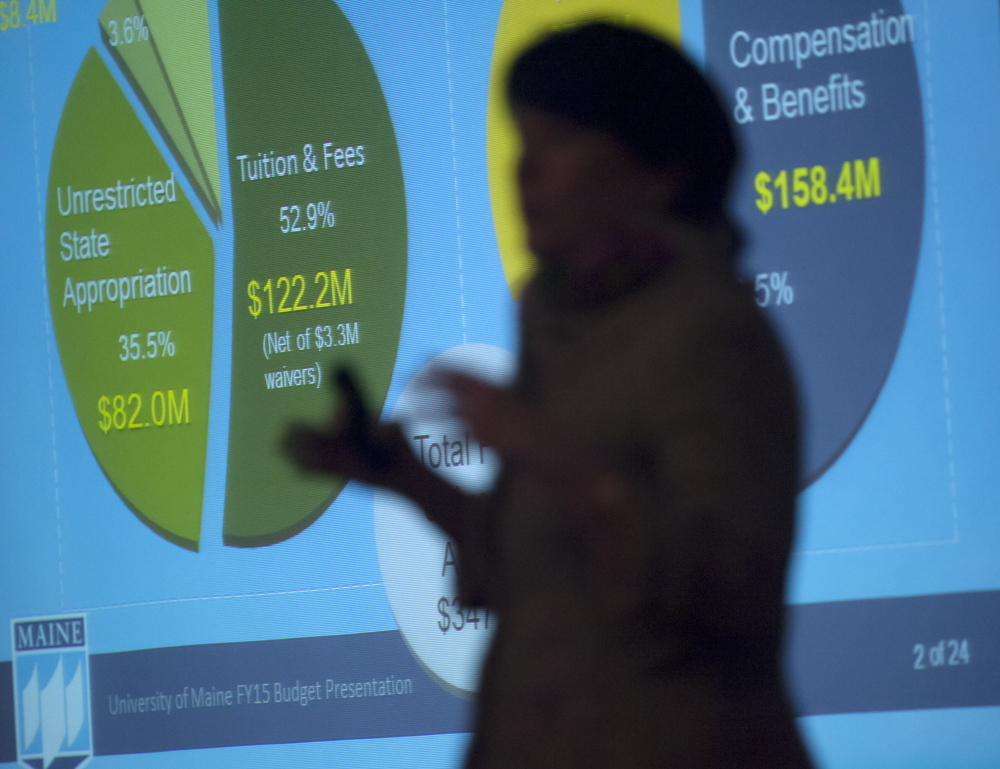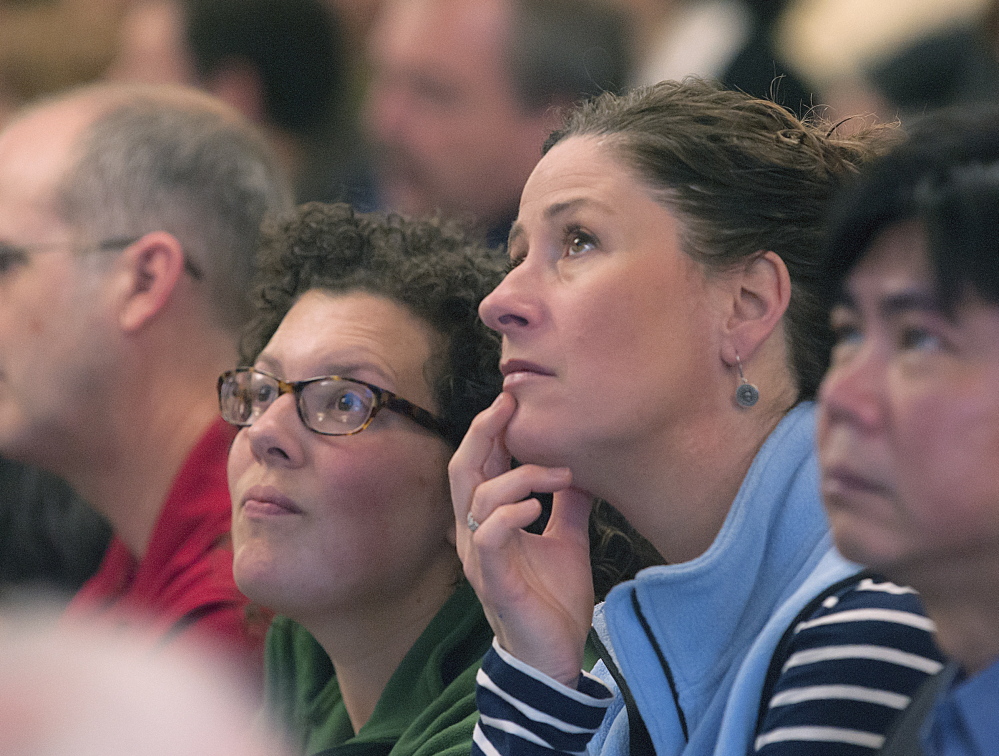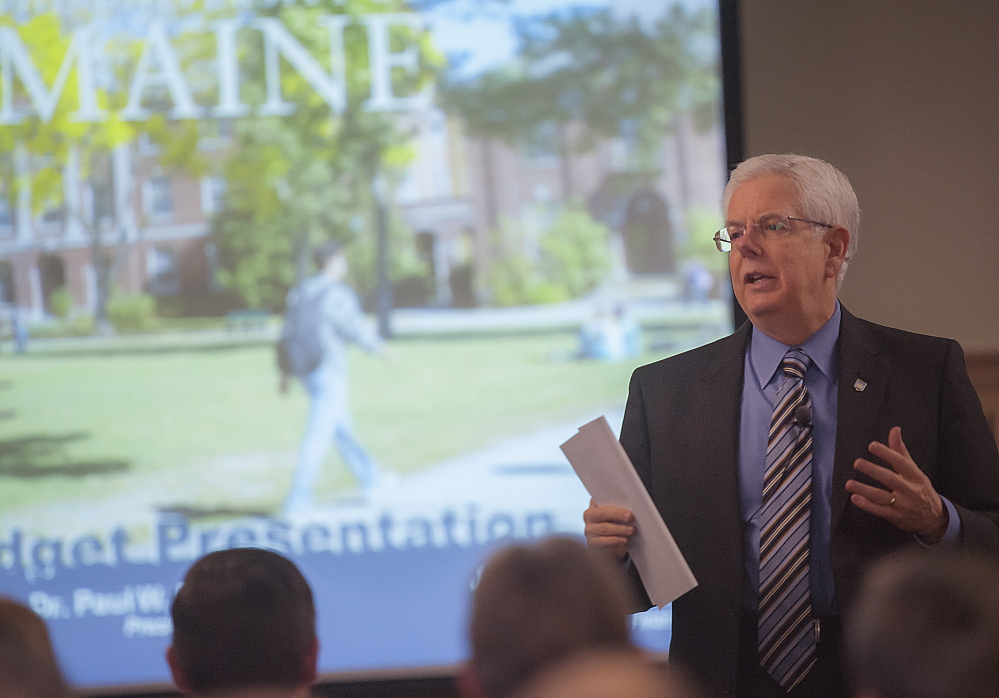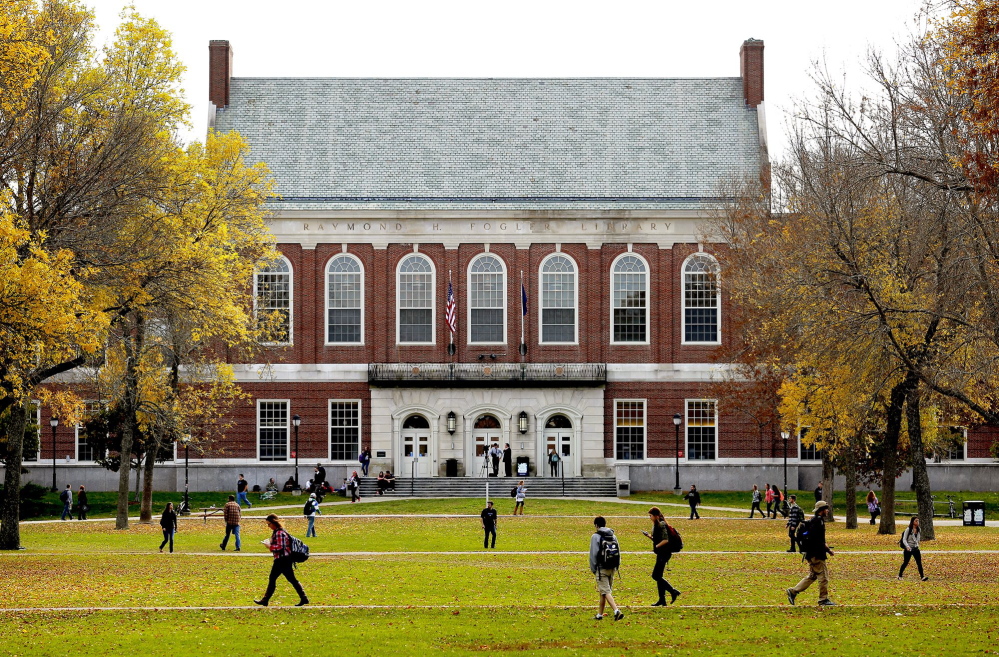ORONO — The University of Maine announced Friday that it will cut about $10 million in the coming year, about 4 percent of its $249 million budget, without laying off any faculty members or eliminating any academic programs.
Most of the savings at the state university system’s flagship campus in Orono will come from leaving positions vacant and laying off about seven non-faculty employees, officials said.
“I wish I could tell you we have reached a profit, (but) I am so pleased by our success, that we are able to get through (2014-15) without going through the retrenchment process of some of our sister campuses,” President Paul Ferguson told a standing-room-only crowd of more than 200 people at the first of two all-campus meetings Friday.
Other savings will come from putting off some hires, not doing construction projects and borrowing against the 2015-16 budget, officials said.
That stands in stark contrast to the system’s second-largest campus, the University of Southern Maine, where students and faculty members are protesting President Theodora Kalikow’s plan to cut four academic programs and eliminate as many as 50 positions, including as many as 30 teachers.
The cuts are part of an effort throughout the seven-campus University of Maine System to eliminate about 165 positions and close a structural deficit of $36 million in the year that starts July 1, caused by flat state funding, declining enrollment and tuition freezes.
They follow years of deep cuts across the system. In this fiscal year, the system closed a shortfall of $42 million, and in 2012-13 it closed a gap of $43 million. Since 2007, the system has reduced its workforce by 10 percent – 521 full-time equivalent employees.
Even with the cuts, officials say revenue falls short of growing expenses, “requiring still deeper cuts in the future combined with new and increasing revenue sources,” according to a multi-year financial analysis done last fall.
The systemwide budget for 2014-15 will be presented to the trustees in May.
‘BLUE SKY PLAN’
As the system’s largest campuses, USM and UMaine in Orono are making the biggest cuts. Both initially faced cutting about 10 percent of their budgets.
UMaine faced a $23 million shortfall, but generated an extra $11 million in tuition last fall through aggressive outreach and new recruitment and used about $2.5 million that was set aside for compensation, shrinking the gap to $9.7 million.
Orono has had more time than other campuses to deal with the issue, officials say. It is already three years into its “Blue Sky Plan,” a long-term collaboration with its staff, faculty and students to come up with long-term reorganization plans.
By contrast, USM launched its comparable effort, the “Direction Package,” last fall.
Both efforts include long-term financial and academic plans aimed at recalibrating the campuses in response to economic and demographic trends that are behind the current financial crisis.
For example, Kalikow says USM must plan for a new base enrollment of about 6,000 full-time equivalent students, far fewer than the roughly 10,000 it had at its peak.
Orono, by contrast, is growing because its plan prioritized boosting enrollment and the university put its resources into new recruitment efforts, particularly seeking out-of-state students, whose tuition is higher. Orono had 11,247 students last fall and a target enrollment of 15,000.
Last year, UMaine used data mining tools for the first time, targeting certain prospective students, and recruited out of state and overseas. That helped to bring in a fall 2013 freshman class of 2,170 students – up from 1,842 last year.
UNFILLED VACANCIES
While there are no faculty cuts in UMaine’s cost-cutting plan, some department heads are wary about the decision not to fill vacant positions.
“For the first time in 45 years, we don’t have a director for English composition,” which serves about 1,600 students a year, said Richard Brucher, chairman of the English department. He said he was told that he could replace the retiring director but the paperwork was suspended recently because of the decision not to fill non-critical positions.
“We’re down three or four (tenure track) professors from 10 or 15 years ago,” Brucher said. “That’s been true across many disciplines.”
Overall, Orono will not fill 25.2 full-time equivalent faculty positions, but will add 10 faculty members in key areas, for a net loss of about 15 positions. Additional information about the unfilled positions, such as their departments, was not available Friday.
Math department Chairman Nigel Pitt said his department has “shrunk a lot” over the years.
“I’m very concerned about the loss of tenure stream faculty,” Pitt said after Ferguson’s presentation Friday. “How we’re going to work that out in the long run, I don’t know.”
UMaine will also eliminate 12 professional and 10 staff positions, for a total reduction of about 37 full-time equivalent positions, said Janet Waldron, senior vice president of finance.
“I won’t say there’s no negative impact from these unfilled vacancies; there’s some impact there,” said Jeff Hecker, executive vice president for academic affairs and provost at UMaine. “We haven’t cut any programs and we’ve developed a plan I’m confident will get us through next year.”
The breakdown of the $10 million in cuts at UMaine is:
• $5 million through reductions in the Division of Academic Affairs, including about $4 million from laying off two non-faculty employees and not filling positions.
• $2.6 million borrowed from the 2015-16 budget, based on early enrollment numbers that show UMaine will have another large incoming class next fall. The university is describing it as “smoothing,” or spreading out, the deficit over several years.
• $1.1 million through reductions in the Division of Administration and Finance, including laying off five non-faculty employees.
• $500,000 through reductions in the Division of Enrollment Management.
• $125,000 by eliminating the traditional library acquisition increase.
• $120,000 through reductions in the Division of Student Affairs.
• $100,000 by eliminating Project 24-7-7 ongoing costs.
FUTURE CHALLENGES
The University of Maine System has fared better than many other state systems, which also have made deep cuts, mostly because of the recession and strapped state governments, according to a report last year by the Washington, D.C.-based Center on Budget and Policy Priorities.
Among the cuts cited in the report: New Hampshire’s university system has eliminated nearly 200 staff positions and frozen hiring and staff salaries; the University of California system has consolidated or eliminated more than 180 programs; Arizona has cut 2,100 positions and consolidated or eliminated 182 colleges, schools, programs and departments; and the University System of Louisiana has cut 217 academic programs.
Ferguson said UMaine still faces challenges in the upcoming years.
“We need more revenues going into (2015-16). I don’t want to downplay that at all,” he said.
He said he had hoped to break even this year, and is now aiming to be in the black next year.
“The reality is, we’ve been making strategic decisions for a number of years now,” said Hecker, the provost. “We’re not happy that we are taking a very large cut, but we feel good about the way we’ve managed it.”
Cecelia McEachern, a freshman majoring in engineering, said it was good news that the university isn’t cutting its faculty or programs.
“I haven’t seen anything” that indicates budget problems, she said.
But Julie Roach, a junior majoring in arts education, said she hears talk in her department about positions not being filled, or concern about possible layoffs.
“It’s a little nerve-racking,” Roach said. “It has an aura of instability.”
Noel K. Gallagher can be contacted at 791-6387 or at:
Send questions/comments to the editors.







Comments are no longer available on this story